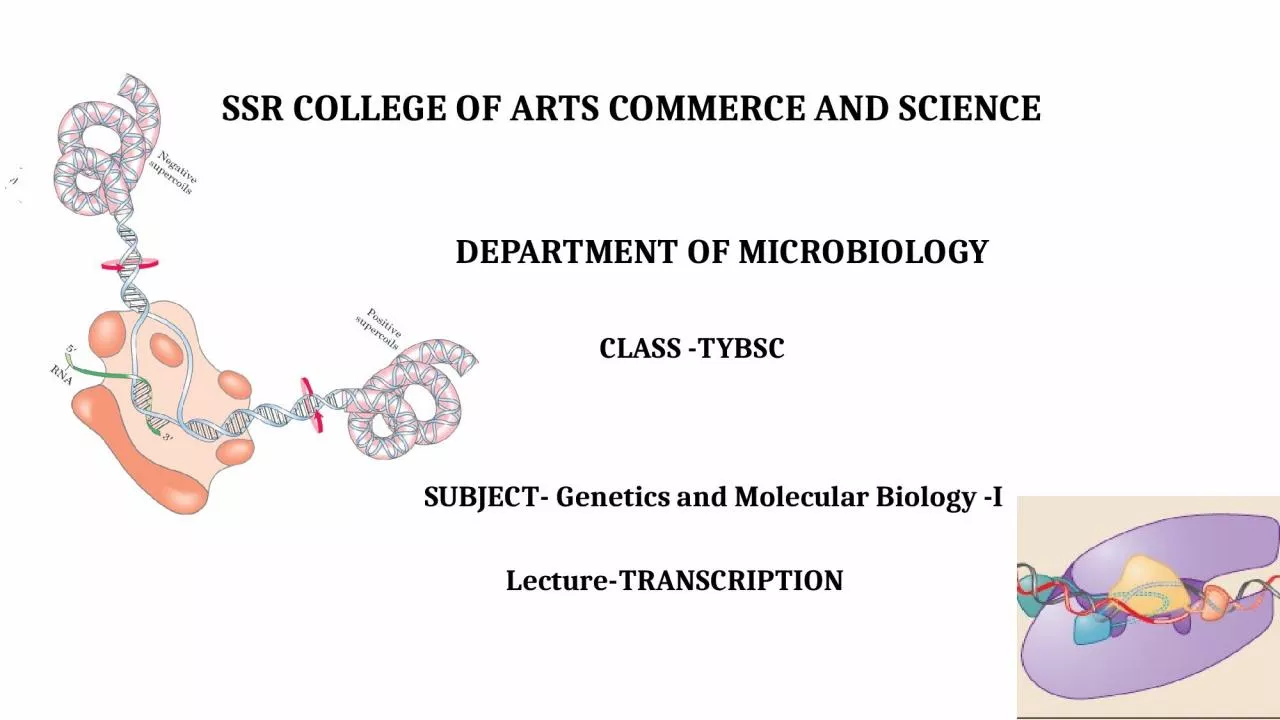

DEPARTMENT OF MICROBIOLOGY CLASS TYBSC SUBJECT Genetics and Molecular Biology I LectureTRANSCRIPTION RNA polymerase Core polymerase 2 3 4 4 3 2 1 70 to 30 ID: 934789
Download Presentation The PPT/PDF document "SSR COLLEGE OF ARTS COMMERCE AND SCIENCE" is the property of its rightful owner. Permission is granted to download and print the materials on this web site for personal, non-commercial use only, and to display it on your personal computer provided you do not modify the materials and that you retain all copyright notices contained in the materials. By downloading content from our website, you accept the terms of this agreement.
Slide1
SSR COLLEGE OF ARTS COMMERCE AND SCIENCE
DEPARTMENT OF MICROBIOLOGY
CLASS -TYBSC
SUBJECT- Genetics and Molecular Biology -I
Lecture-TRANSCRIPTION
Slide2Slide3Slide4RNA polymerase
Core polymerase
Slide5Slide6Slide7+2 +3 +4 -4 -3 -2 -1
Slide8-70 to +30
Slide9Slide10Slide11Slide12INITIATION
–11 to +2
isomerization
Slide13Slide14ELONGATION
Slide15Two proofreading functionspyrophosphorolytic editing-back-reaction, to catalyze the removal of an incorrectly inserted ribonucleotide,By reincorporationof Ppi
hydrolytic
editing- polymerase
backtracks by one or more nucleotidescleaves
the RNA product, removing the error-containing sequence
Slide16Elongation Factors- Gre factors -
stimulate Hydrolytic editing Serve as elongation stimulating factors by helping to
overcome
“
arrest” at sequences that are difficult to transcribe
Nus
proteins-
promotes
, in still rather undefined ways, the
processes
of
elongation and termination
Slide17Termination Terminators- sequences that trigger
the elongating polymerase to dissociateFrom the
DNA and release the RNA chain it has made
Rho-dependent-
requires the action of the Rho factor
rut sites
for Rho utilization , stretches of 40
nucleotide on RNA transcript
Slide18Slide19Rho-independent/intrinsic terminators they need no other factors to work
Consist of two sequence
elementsinverted repeat (of 20 nucleotides
) stretch of about eight A:T base
stem-loop
structure/ “hairpin”
pairs
they
function in the RNA rather
than in
the DNA.
Slide20Slide21Slide22TRANSCRIPTION IN EUKARYOTESpolymerases closely related to the RNA polymerases found in prokaryotesprocess of transcription itself is identical in the two
cases
Bacteria Eukaryotes only one RNA polymerase at
least three different ones (Pol I, II, and III)
only one additional initiation factor (sigma), several initiation factors, general transcription
factors
(GTFs
)
general transcription factors are not alone sufficient to bind
promoter sequences.
additional factors
are required,
including
DNA-binding regulatory proteins,
the
so-called
Mediator complex
,
and
often chromatin-modifying enzymes
.
Slide23Eukaryotic core promoterminimal set of sequence elements
required for accurate transcription initiation
by the Pol II machinery40–60 nucleotides long
Slide24Regulatory sequences-there are other sequence elements required for accurate and efficient transcription in
vivo
PromoterproximaL elements, Upstream activator
sequences (UASs)
enhancers, and a series of other elements called silencers,
activators
and repressors
Slide25Preinitiation complex TBP (TATA-binding protein)
TFIID-TATA element-
TAFs, for TBP-associated
factors
Inr, DPE, and DCE,
TFIIA,
TFIIB,
TFIIF together with
polymerase,
TFIIE and TFIIH.
Formation of the
preinitiation complex
is
followed by promoter
melting
requires
hydrolysis of ATP
and is mediated by
TFIIH
Slide26Promoter escapeATP hydrolysisphosphorylation of the polymerase
carboxy-terminal domain (
CTD)-Heptapeptide repeats –
Tyr-Ser-Pro-Thr-Ser-Pro-Ser.
27 in
the yeast
32 in
C
elegans,
45 in
Drosophila,
52
in humans.
Slide27Elongationelongation factors Factors required for RNA processing
the kinase
P-TEFb
-phosphorylates the serine residue at
position 2 of the CTD repeats -
phosphorylates and thereby activates
another protein, called SPT5
,
TAT-SF1
, yet another elongation factor, is recruited by
P-TEFb .
Slide28Post transcription Modifications Capping
addition of a modified
guanine base to the
5’ end of the RNA,
methylated guanine
Slide29Slide30polyadenylation
Slide31Transcription TerminationRNAase in yeast, Rat in humans, Xrn2
protein (
Rtt103) loads
torpedo
allosteric.
Slide32RNA Splicing
Slide33introns and exons borders
four classes of introns- group I and
s
elf-splicing group
II introns
Splicosomal Introns
t RNA , endonuclease ,ligase
Slide34Splicing mechanism of group Iintrons
Slide35Splicing mechanism of group IIintrons
Slide36Spliceosomal intronsSpliceosome 5 Small nuclear RNAs (snRNAs), 100 and
300 nucleotides lon 150
proteins
snRNAs
- U1, U2, U4, U5, and U6
snRNPs “snurps
-
SnRNAs
+ Proteins
Slide37Slide38ECB
A
Slide39Slide40Regulation OF Transcription Regulatory Proteins positive regulators, or activators negative regulators, orrepressorsBasal level transcription – Promotor sequence
gene expression
constitutive- housekeeping
genes regulated - inducible, repressible.
Slide41Slide42